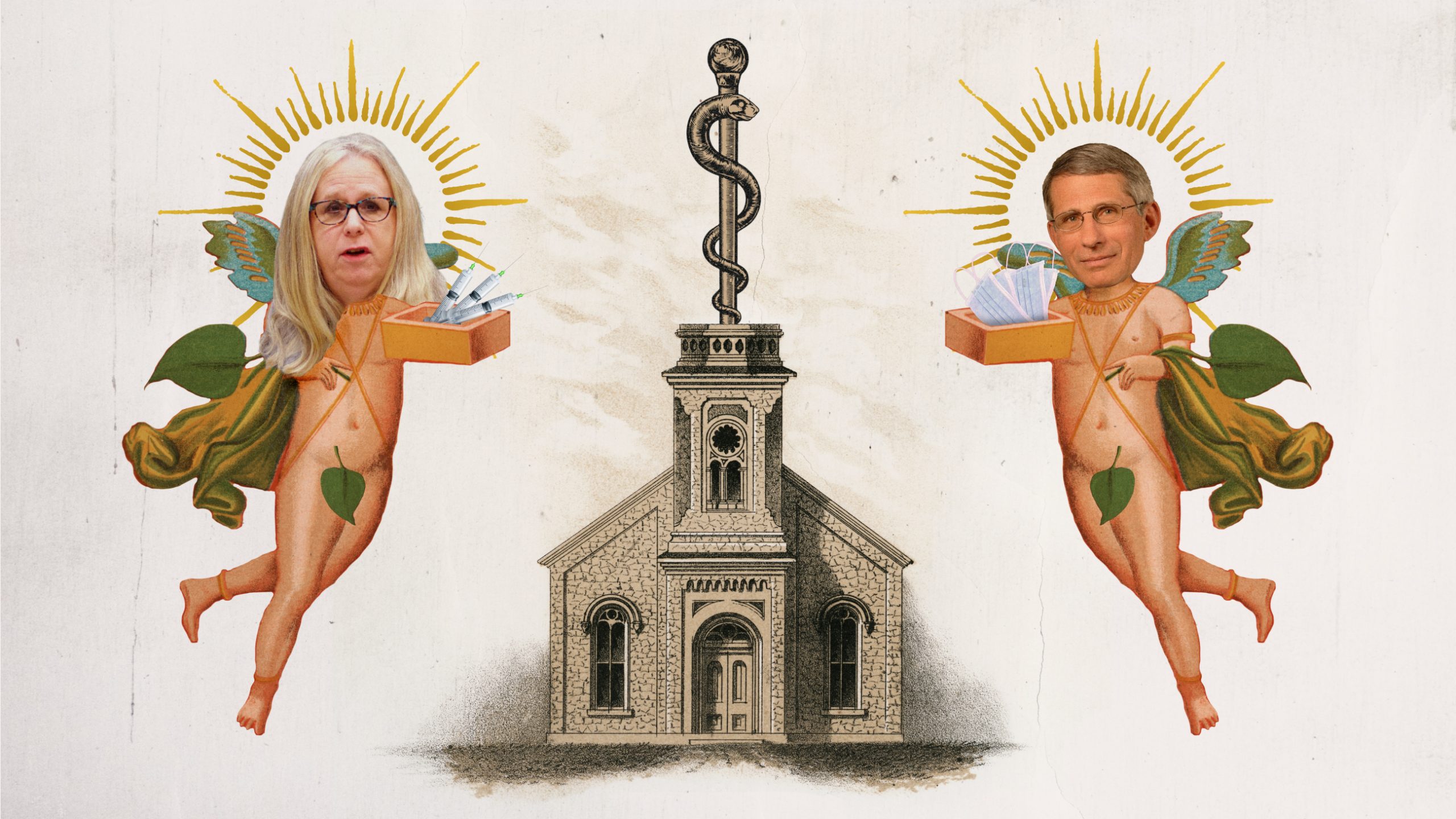The Zombie Enlightenment enslaves us to a new religion.
Body Positivity

The digital era has awoken an ancient revulsion with the flesh.
Your body is a problem. That much is obvious. It’s a problem on its own terms, because it breaks down and one day it will die. But it’s also a problem on your terms, because it doesn’t always do what you tell it to. What you want is a perpetual motion machine that answers to your every whim. What you have is a sputtering clunker that will one day be sold for scrap.
The good news is, everyone has always had this problem. Many wise people have struggled painfully to describe how the body does, or should, relate to the soul. Or to the mind, or the psyche, or the nefesh, or whatever else you want to call that other aspect of what you are.
It is difficult enough just to say in words what this “other aspect” is. Plato devoted extensive literary effort to conveying it via metaphor: perhaps it is a rational charioteer, struggling to exert control over a chariot drawn lopsidedly along by appetites and moral sentiment (Phaedrus 246a-254e). Or else maybe a puppet pulled by strings of vision and desire, led at last aright by the golden thread of reason (Laws 644d-645c). But it’s harder still to say how this strange and shifting self, this thing of hunger and pleasure and dreams and thought, fits into the body. What has the soul to do with matter? If we are spirits, why this meat sleeve?
Plato seems to have considered that a question best answered, if at all, by mystics and sages. When Socrates’ disciple Simmias made an attempt, Socrates gently but definitively picked Simmias’ argument apart. The soul is not only, as Simmias suggested, a certain configuration of the body in harmony, as the strings of a lyre are arranged to make a scale. If anything, it is more like the man who tunes the lyre in the first place: the soul brings all the components of us into their proper place and order, “sometimes keeping them harshly in check with painful measures like gymnastics and medicine, and sometimes using milder methods, threatening and persuading by turns” (Phaedo 94c-d).
So this soul of ours is in but not of the body. It is nowhere to be touched or smelled or seen, but it makes itself known by its power over our actions in the world. Timaeus, a Pythagorean visitor from the Italian coast, represents the soul as having been shunted rudely into a body where, during a brief sojourn, it must bring the many passions to heel in rational order—just as the whole material cosmos, governed by its own soul, moves and changes according to predictable patterns (Timaeus 42d-44d). The motions of planets and the laws of physics are outward expressions, in Plato, of a pure and ineffable logic which our human souls also express in miniature. We recognize the rational order of things because it is in us, too.
But when Plato’s views are taken too literally or carried to excess, they produce errors with which we are all well acquainted. Plato himself sometimes talks as if the world of soul and reason is somehow real while the world of body and matter is a cumbersome distraction (see e.g. Phaedo 77c-9b). So his later followers can be forgiven for expressing disgust with the indignity of incarnate life: “Plotinus seemed ashamed of being in the body,” writes Porphyry by way of introduction to the man who is now considered the founder of “Neoplatonism.” Plotinus welcomed the end of his earthly life as a release from the grime of flesh: “I am reaching to give back the God in myself to the God in the all,” he said, and died (Life of Plotinus 1-2).
Body Negativity
Plotinus’ view is back in fashion. “I’m not body-positive,” purrs one young woman in a viral tik-tok video: “I’m body-negative. I want to be vapor…. Because like, gender? Humiliating…. Every day I wake up and I’m subject to the burden of embodiment. How dare I be a shape? Disgusting.” I suspect that this profound and ancient revulsion at having a body is motivating a lot of otherwise apparently crazy youth trends that have emerged in the digital age.
Consider the sudden gen-z rush to identify as transgender or non-binary. Some kids report that acute confusion about their gender emerged out of a more profound and sustained horror at the body generally, like a ripple on the surface of deeply troubled waters. In Irreversible Damage, Abigail Shrier interviews a girl whose anorexia transformed almost instantly into a fixation on becoming male: “My goal went from diet pills to testosterone…. From fantasies about slicing off my thigh fat to slicing off my breasts. I bound them with duct tape. I couldn’t breathe. It made me panic, but I felt brave.”
The transsexual internet personality Buck Angel speculates, along with Shrier, that this trans kid craze is related to the plummeting interest in sex among teens. “Trans identification may be celebrated as a moment of liberation,” writes Shrier, “but for many teens suddenly identifying, it very often seems to be a sad cult of asexuality, like the hand-painted sign in an antique shop reading ‘Please Do Not Touch.’” Maybe these kids aren’t so much trans as they are repulsed by the idea of their own nakedness, the terrible potential for exposure and shame that comes along with bodily desire. Gender? Humiliating.
The “body-positivity” movement, remember, is itself a reaction against what digital technology has done to our ambivalence about having bodies—namely, thrust it into a heady kind of overdrive. Celebrities can now photoshop themselves into cartoonish images of youth and beauty, pasting the hips and breasts of a fertility goddess onto a tight-bellied figure that could never survive actual childbirth. Recently an unretouched photo of Khloé Kardashian (looking gorgeous, but not meticulously airbrushed) leaked online. The Kardashian team did everything they could to hurl the picture down the memory hole: anything other than flawlessly idealized perfection is, for them, a PR risk.
Girls are thus left without realistic models of what female beauty can be like in all its stages—from girlish innocence, to motherhood, to matronly dignity. Small wonder that this induces in them all manner of hysteria about their own normal—and thus disappointing—physical forms. Small wonder, too, that they take this out on themselves in a million ghastly ways—from cutting, to double mastectomy, to self-starvation, to defiantly heedless gluttony. Hence the “fat positive” and “body positive” movements, with their efforts to declare obesity healthy and beautiful.
But trying to correct deceptive imagery with bald-faced lies is like trying to fight fire with kerosene. It is no less dishonest to tell fat girls they are beautiful and healthy, than to tell them they can look like Khloé Kardashian. The result is more discomfort in your own skin, not less: Madison Malone Kirchherr, a podcaster at Slate and thus no friend of traditional beauty standards, nevertheless complains that the online ricochet between positive affirmation and micro-scrutiny “leaves me fairly confused and anxious about how I’m supposed to feel about my stupid body.”
How indeed. It’s worth noting that body escapism, embraced on whatever terms you may choose, usually induces self-destruction. Plotinus suffered regularly from intestinal illness but refused medication, which he considered impure and undignified. He also eschewed exercising in the baths, where nudity and sweat would have reminded him painfully of what he was. The result of all this was diphtheria.
“I hate this place, this zoo, this prison, this ‘reality,’ whatever you want to call it…. It’s the smell. If there is such a thing…. I can taste your stink.” That could have been Plotinus speaking of the material world. In fact it was the villainous digital program Agent Smith, torturing the human rebel Morpheus in The Matrix, by the Wachowski brothers—who, remember, are now the Wachowski sisters.
I have no beef with trans adults living as they choose. I’m suggesting something quite different: that radical gender theory is just one outgrowth of a bigger pattern. It seems the more we live online, the more we are tormented by the sight and stench of flesh. Yet our efforts to transcend matter, whether ancient or modern, render us neurotic and sick.
No Exit
There is no escape. That’s the whole problem. After all our striving, we are forced to conclude that the body is not just an appendage, not just an encumbrance or a distraction to be shucked off as soon as possible. “I see the body almost as a toy or a pet that I can play with,” says trans performance artist Pippa Gardner, but she’s wrong. There is something essential about the body, something necessary, something even—somehow—good.
And so “the end of all our exploration / Will be to arrive where we started:” we come back around, sooner or later, to “the beginning.” “Then the LORD God formed man of the dust of the ground, and breathed into his nostrils the breath of life; and man became a living soul.”
We tend to overlook a central part of this creation story. The words “living soul” (nefesh chayyim) describe not the disembodied breath of life, nor the clay figurine into whose nostrils God breathes, but the whole complex of united body and breath. When divine consciousness and inert clay were fused together as one, then man “became a living soul.” Maybe human souls are not separate from human bodies after all. Maybe our bodies are somehow an essential part of what we are.
That, in a nutshell, is why Neoplatonists like Porphyry reacted so vehemently against the rise of Christianity. That God himself should choose matter, should even dwell in it and give his flesh to us as food, struck Porphyry as “not merely bestial and ridiculous, but more absurd than any absurdity, more bestial than any kind of beast” (Against the Christians). How dare they subject God to the mockery of having hands and feet, of spitting in the dust and making paste to heal a blind man’s eyes? For that matter, how dare they value sight of the merely physical kind at all?
In fact, though, the Christian idea that a human body could be divine gets closer to expressing what really frustrates us about our own fragile, mortal bodies. Because in essence we are not sorrowful simply that our bodies exist. We are sorrowful that they do not do everything we feel certain they can and should. The mere idea that our bodies break down implies we believe they have some potential they are not living up to. And indeed if our bodies are the site of pain and dejection, they are also the place—the only place—where our highest and noblest virtues find expression.
There is no such thing as pure charity in the abstract without some act of charity in the flesh—if you really want to feed a man you cannot simply will him to be fed. You must take bread in your hands and give it to him, let him chew and swallow and digest it. Likewise courage is mere pretense unless it is lived out, unless at the moment of truth you really do stand on your feet where others cower. “Whoever claims to love God yet hates a brother or sister is a liar. For whoever does not love their brother and sister, whom they have seen, cannot love God, whom they have not seen.”
Our aspirational idea of a soul set free from the body is just that: an idea. In practice our reason, our desires, our vices and our virtues all play out in time and space. We know no other kind of existence than this. Hence we experience the failure of our bodies and their eventual death not as a matter of course but as a fall, as a direct consequence of the Fall. We intuit that our bodies are supposed to be infused with that love which made the world and lives forever.
We even see how human bodies can, at their peak of health, display some visual shadow of an invisible beauty which we adore to the point of distraction. The intensity of rapture we call sexual arousal is a natural response to seeing a body which suggests to us a supercharged potential, a potential for the ecstatic kind of love which in its highest form creates life. It seems wrong to us—it is wrong—that something so miraculous should ever die.
Just Do It
The initiated will know that the fancy word I am working toward here is hylomorphism, or “form-in-matter.” Aristotle, as baptized by St. Thomas Aquinas, helps us recognize that the soul is distinct, but never severed, from the body. We may hope that our soul will be transferred to a new body at the resurrection, but not that we will be released from having any body whatsoever. What we are about—for all eternity if we’re lucky—is imbuing matter with the form of God’s image.
I could throw more citations at you, could go on about the soul being “the first actuality of a natural body that has life potentially” (De Anima 412a; cf. Summa Theologiae PI Q76), could bring in witnesses like Milton (Paradise Lost 4.742-6) and C.S. Lewis (Screwtape Letters Ch.4) and so forth. I suppose I could mention Descartes. But you can look all that up for yourself, or else you have read it already. And anyway, more importantly, the implication of what I’m saying is that you will not fix your relationship with your body by thinking about it, by getting just the right idea in your head about things.
If anything the overemphasis on thinking without doing is what has us all so fat and sick and infertile. Your mind is important and can lead you. But so can your body, which is not a mere vassal slave but a copartner with your soul in becoming human. Your restless impulses, your physical desires, that tingle that you have on the back of your neck: these things have something worthwhile to tell you, too. Hierarchy does not imply subjection. Mind wields power over matter, but that does not mean matter has nothing to offer mind.
The way to get in shape is not to argue with yourself about whether to go to the gym today: the way is to stop thinking, sack up, and do it. The arguments for and against asking that hot girl out may be variously persuasive or not, but the future belongs to those who simply plunge in. Even prayer, which we have been taught to regard as little more than thinking nicely about God, is easier if you simply fall on your knees, clasp your hands together, and say something out loud—including if that something is “God, I’m not sure you exist.” Instead of trying to logic it all out beforehand, see what happens if you let your gut lead.
The online movements I find most charismatic all share this governing impulse. Against the demands that we eat bugs for efficiency’s sake, against COVID-era efforts to upload work, church, and consciousness itself into the Zoom cloud, against atrophy and diffidence and self-contempt, there are people out there seeking a human way forward in the digital age. There are right-wing bodybuilders, tradmoms, neo-humanists and co-religionists, all making a home for themselves here on earth.
That is, after all, the only home we have. Even when we die, we will not be beamed up into the ether. “I saw the holy city, the new Jerusalem, coming down out of heaven.” We are not getting evaporated up into paradise: paradise is coming down here to us, solid and secure as a palace of marble and stone. “And I heard a loud voice from the throne saying, ‘behold. The dwelling place of God is with man.’” Behold: the dwelling place of the soul is the body—and in spite of it all, it is very good.
The American Mind presents a range of perspectives. Views are writers’ own and do not necessarily represent those of The Claremont Institute.
The American Mind is a publication of the Claremont Institute, a non-profit 501(c)(3) organization, dedicated to restoring the principles of the American Founding to their rightful, preeminent authority in our national life. Interested in supporting our work? Gifts to the Claremont Institute are tax-deductible.
Liberal feminism relentlessly aggresses against the female body and soul.
Human bodies are irrevocably either male or female. Attempts to change that are recklessly destructive.
Finding a middle ground between Kardashian bod and blobby positivity.




